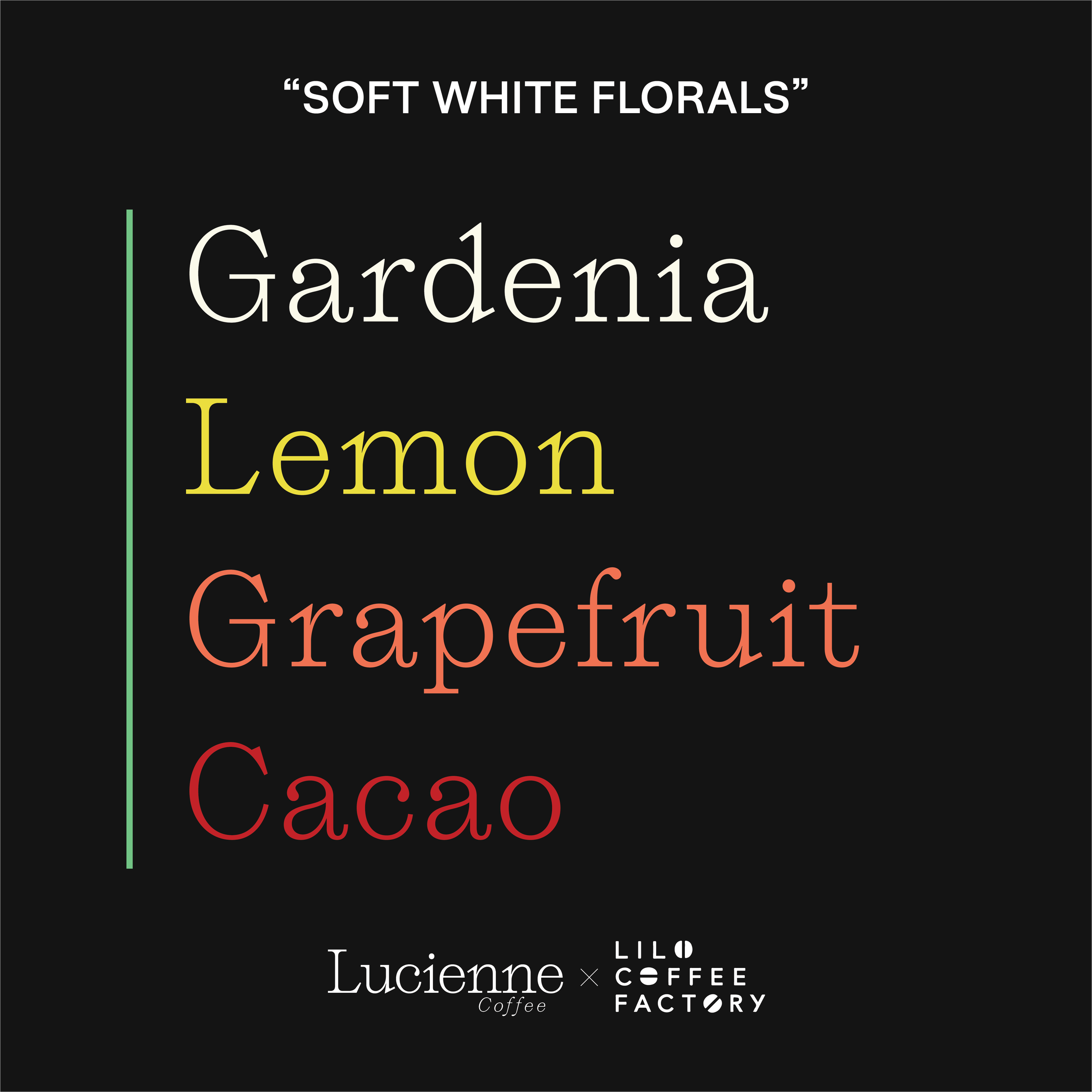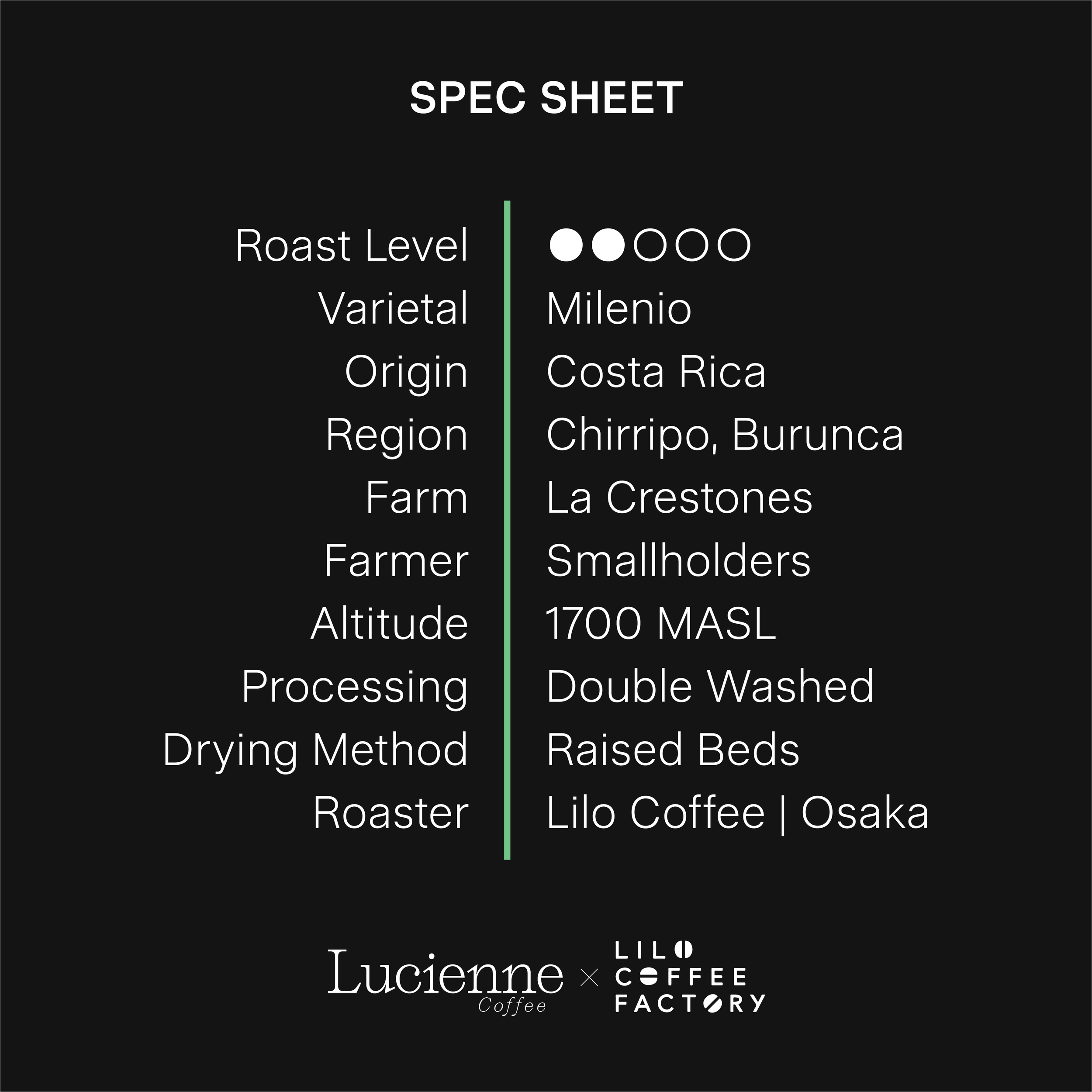 Image 1 of 3
Image 1 of 3

 Image 2 of 3
Image 2 of 3

 Image 3 of 3
Image 3 of 3




Los Crestones Double Wash Milenio
Josh’s notes:
A new varietal I’ve never tried- Milenio! (we also have another!) This coffee has a nice white flower aroma to it reminiscent of gardenias and jasmine. It’s a bit like lemon tea brewed with a bit of jasmine, and a lovely and subtle grapefruit acidity that keeps things interesting. Super clean with that double-wash too.
It’s more in-your-face than similarly noted geishas which is a big win for those who aren’t geisha crazy. I’m very much looking forward to more Milenio in the future!
Lilo’s Notes:
“Los Crestones Mill is a cooperative of ten coffee-producing families in a small village in southern Costa Rica. It is located at the foot of Cerro Chirripó, the highest peak in the country.
Coffee was not traditionally cultivated in this region. Instead, locals were known for growing delicate crops such as tomatoes and bell peppers. Over time, they recognized the potential of coffee as a valuable crop and gradually shifted their focus to coffee farming.
However, coffee from the Brunca region was considered to be of lower quality, leading to a decline in market value. Since much of it was grown at lower altitudes, prices fell, making it difficult for producers to earn a stable income.
To overcome this challenge, ten families came together and made the bold decision to establish their own processing mill to produce higher-quality coffee.
Fifteen years later, their efforts have proven successful. They continue to work together, growing and processing coffee that is now exported worldwide
One of the defining characteristics of this lot is the presence of very old and large oak trees scattered among the coffee plants.
While other farmers cut down oak trees to increase sun exposure, these families chose to leave them untouched. The presence of these towering oaks creates a unique growing environment for coffee and contributes to improved soil conditions.
In addition to common coffee varieties, this farm also cultivates Milenio, a hybrid variety known for its strong disease resistance, early maturation, and high productivity, along with an outstanding cup profile. However, investing in new varieties carries risks, which is why many farmers hesitate to adopt them.
Despite these challenges, Los Crestones took on the cultivation of Milenio and achieved exceptional results. In one year, their Milenio coffee placed third in the Cup of Excellence competition.
Milenio is an F1 hybrid created by crossing the rust-resistant T5296 variety with Sudan Rume, a native Ethiopian variety. It was jointly developed by the French research institute CIRAD, the Central American coffee research network PROMECAFE, and CATIE. F1 hybrid coffee varieties are relatively new to the coffee industry, and only a limited number have entered the market over the past 15 years.
This lot is processed using the traditional double-washed method.
First, the coffee cherries are rested for a short period before being pulped, leaving some mucilage intact. The parchment is then transferred to a large open tank and submerged in fresh water.
After 12 to 18 hours of fermentation, the mucilage is completely removed by stirring. Finally, the parchment coffee is thoroughly washed with fresh water, resulting in a clean and transparent final product.
The parchment coffee is first dried for approximately eight days on raised drying beds in a greenhouse, where it is frequently turned. It is then further dried for two days on concrete patios or in mechanical dryers to achieve the ideal moisture level..”
Roast:
Roasted light and spectacularly by our friends at Lilo Coffee Factory in Osaka, Japan.
Josh’s notes:
A new varietal I’ve never tried- Milenio! (we also have another!) This coffee has a nice white flower aroma to it reminiscent of gardenias and jasmine. It’s a bit like lemon tea brewed with a bit of jasmine, and a lovely and subtle grapefruit acidity that keeps things interesting. Super clean with that double-wash too.
It’s more in-your-face than similarly noted geishas which is a big win for those who aren’t geisha crazy. I’m very much looking forward to more Milenio in the future!
Lilo’s Notes:
“Los Crestones Mill is a cooperative of ten coffee-producing families in a small village in southern Costa Rica. It is located at the foot of Cerro Chirripó, the highest peak in the country.
Coffee was not traditionally cultivated in this region. Instead, locals were known for growing delicate crops such as tomatoes and bell peppers. Over time, they recognized the potential of coffee as a valuable crop and gradually shifted their focus to coffee farming.
However, coffee from the Brunca region was considered to be of lower quality, leading to a decline in market value. Since much of it was grown at lower altitudes, prices fell, making it difficult for producers to earn a stable income.
To overcome this challenge, ten families came together and made the bold decision to establish their own processing mill to produce higher-quality coffee.
Fifteen years later, their efforts have proven successful. They continue to work together, growing and processing coffee that is now exported worldwide
One of the defining characteristics of this lot is the presence of very old and large oak trees scattered among the coffee plants.
While other farmers cut down oak trees to increase sun exposure, these families chose to leave them untouched. The presence of these towering oaks creates a unique growing environment for coffee and contributes to improved soil conditions.
In addition to common coffee varieties, this farm also cultivates Milenio, a hybrid variety known for its strong disease resistance, early maturation, and high productivity, along with an outstanding cup profile. However, investing in new varieties carries risks, which is why many farmers hesitate to adopt them.
Despite these challenges, Los Crestones took on the cultivation of Milenio and achieved exceptional results. In one year, their Milenio coffee placed third in the Cup of Excellence competition.
Milenio is an F1 hybrid created by crossing the rust-resistant T5296 variety with Sudan Rume, a native Ethiopian variety. It was jointly developed by the French research institute CIRAD, the Central American coffee research network PROMECAFE, and CATIE. F1 hybrid coffee varieties are relatively new to the coffee industry, and only a limited number have entered the market over the past 15 years.
This lot is processed using the traditional double-washed method.
First, the coffee cherries are rested for a short period before being pulped, leaving some mucilage intact. The parchment is then transferred to a large open tank and submerged in fresh water.
After 12 to 18 hours of fermentation, the mucilage is completely removed by stirring. Finally, the parchment coffee is thoroughly washed with fresh water, resulting in a clean and transparent final product.
The parchment coffee is first dried for approximately eight days on raised drying beds in a greenhouse, where it is frequently turned. It is then further dried for two days on concrete patios or in mechanical dryers to achieve the ideal moisture level..”
Roast:
Roasted light and spectacularly by our friends at Lilo Coffee Factory in Osaka, Japan.
